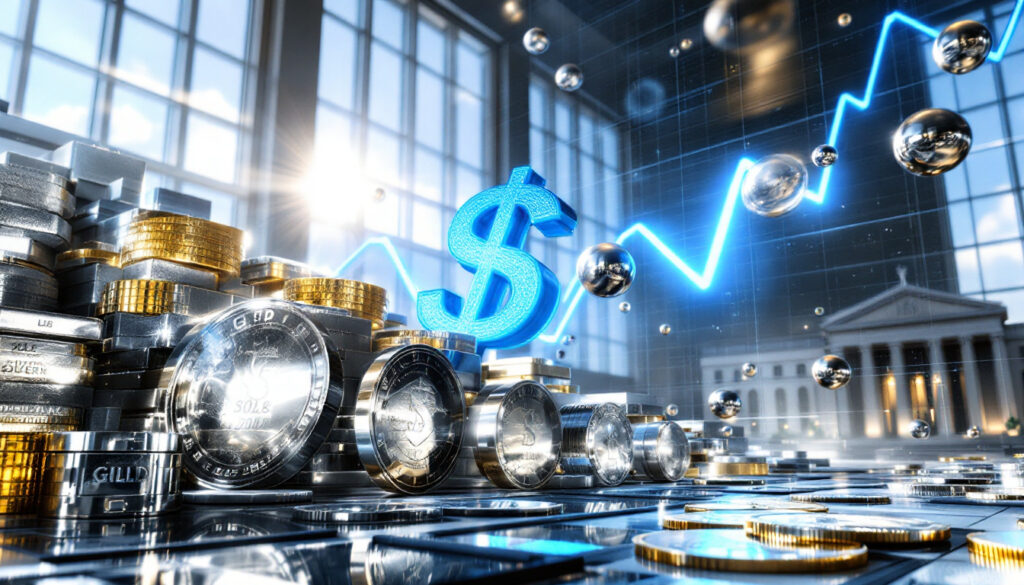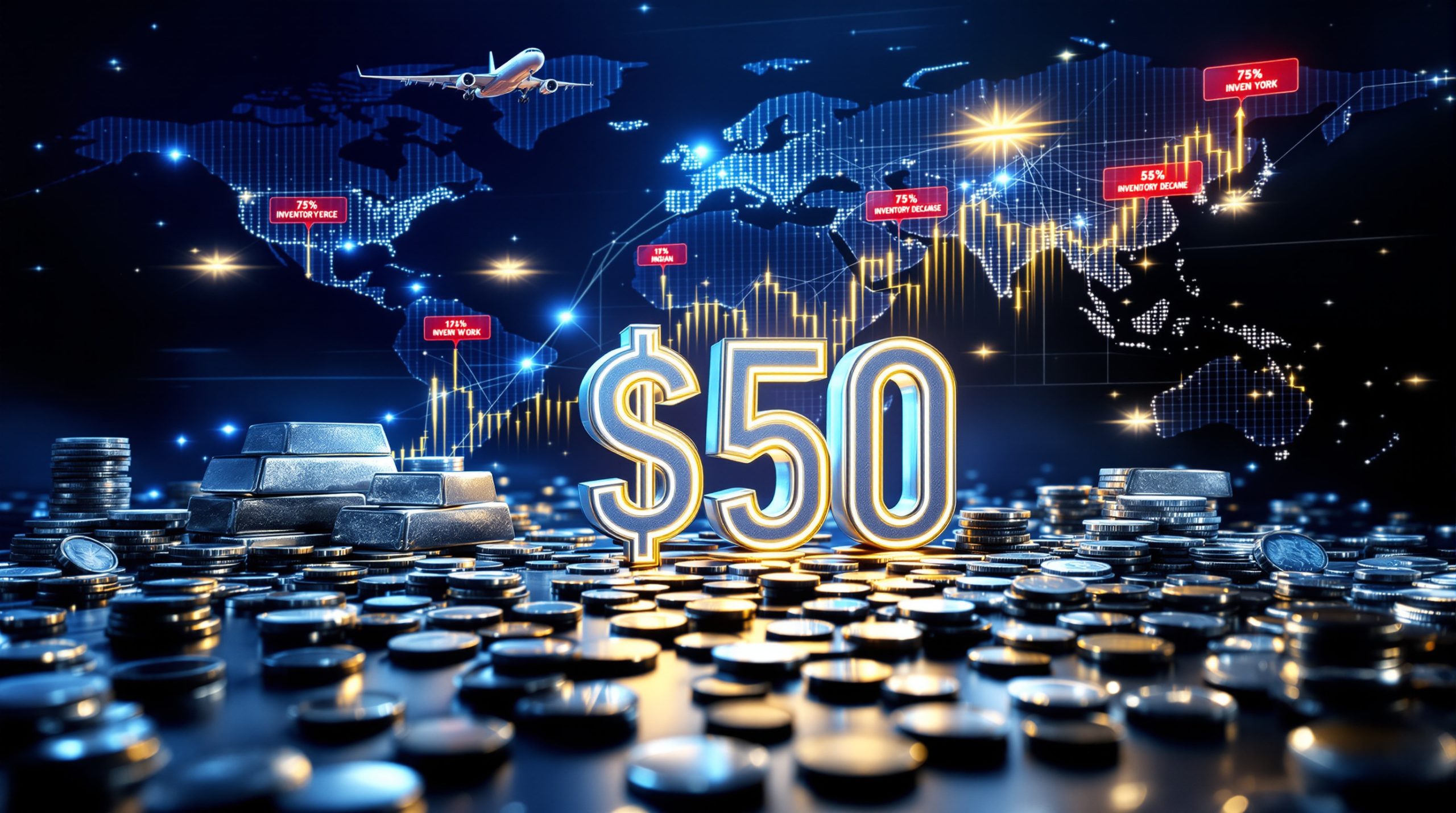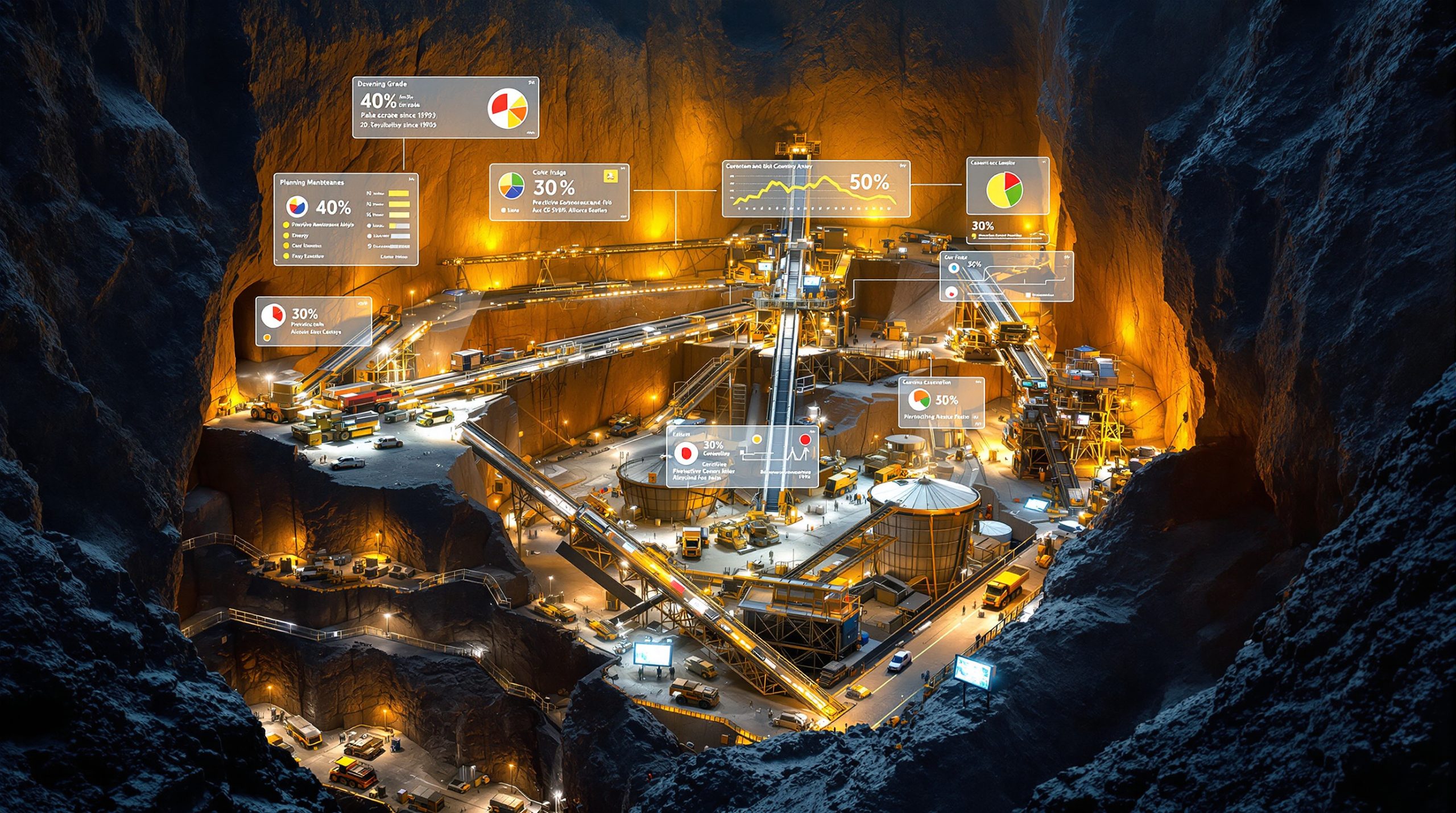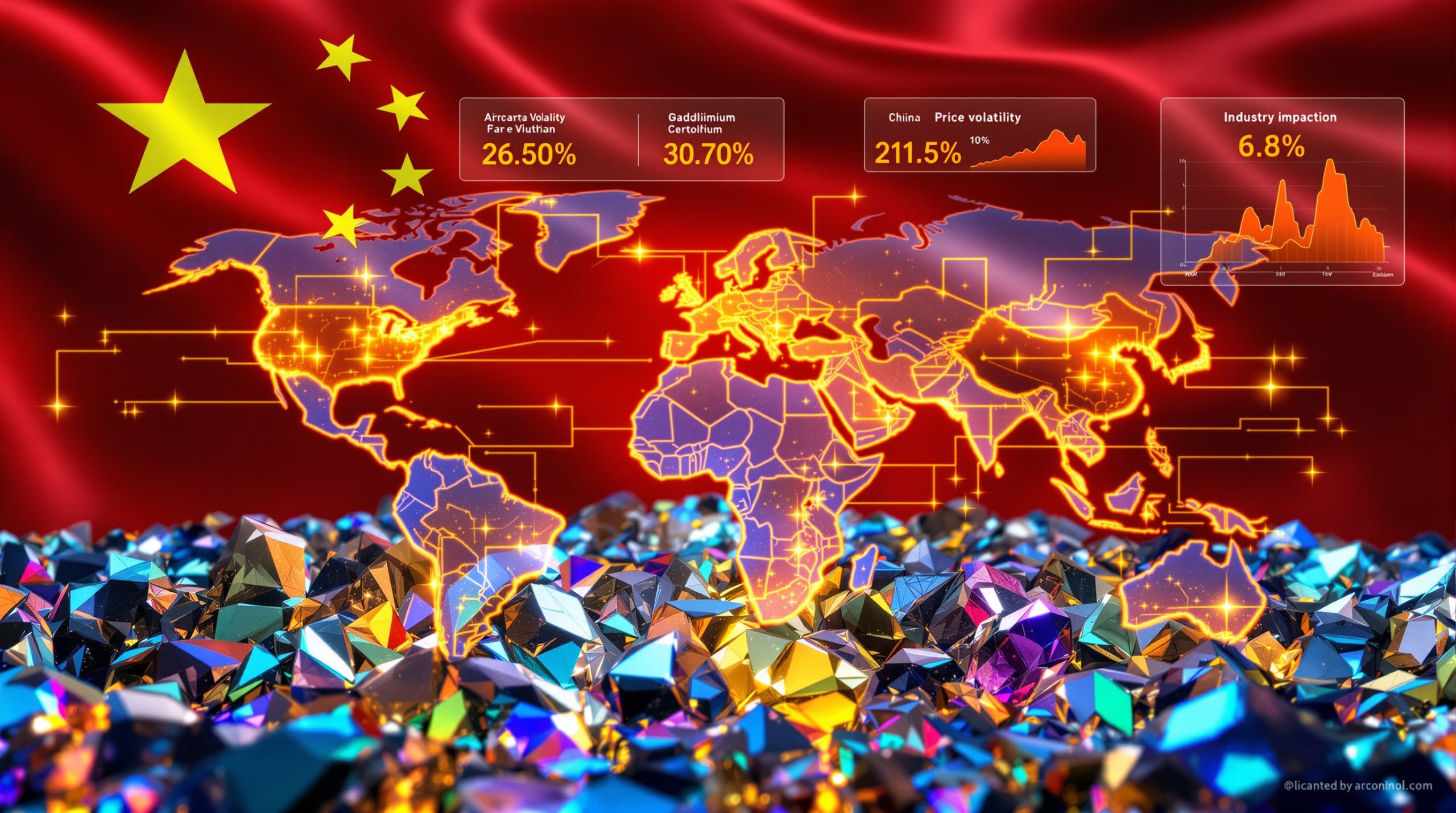What Caused the Recent Silver Price Drop?
The silver market has experienced a notable decline recently, with several key factors contributing to the downward pressure on prices. Understanding these driving forces is essential for investors navigating the precious metals landscape in 2025.
Federal Reserve's Interest Rate Decision
The Federal Reserve's recent decision to maintain interest rates at the 4.25-4.5% range marked the sixth consecutive hold since December 2024, creating significant headwinds for silver and other precious metals. Fed Chair Jerome Powell's announcement set a cautious tone for the markets, stating:
"It's still appropriate to keep rates on hold. We're at a pause. We're at the right place to wait and see how things evolve."
This "wait and see" approach signals the central bank's careful monitoring of economic indicators before making any policy shifts. The Fed officials voted unanimously to maintain current rates, reinforcing their commitment to this strategy.
Higher interest rates typically create a challenging environment for non-yielding assets like silver. When rates remain elevated, investors often gravitate toward interest-bearing investments rather than precious metals that don't generate income, putting downward pressure on silver prices.
Strengthening US Dollar
Following Powell's comments, the US dollar gained significant strength against major currencies, creating additional pressure on dollar-denominated commodities like silver. This inverse relationship between the dollar and precious metals prices is a well-established market dynamic.
Silver experienced a particularly steep decline of 2.3%, dropping below the psychologically important $33 per ounce level to $32.53. By comparison, gold showed more resilience with a more modest fall of approximately 2% to $3,369 per ounce. This divergence highlights silver's typically higher volatility relative to gold during market adjustments.
The metal's dual nature as both a monetary and industrial asset makes it especially susceptible to macroeconomic shifts. With approximately 50% of silver demand coming from industrial applications, economic outlooks significantly influence price movements.
Potential Trade Negotiations
Reports of high-level meetings with Chinese officials have somewhat eased trade war concerns, contributing to silver's recent weakness. Secretary Scott Bessant confirmed under oath that negotiations are currently underway with 16 major countries, including China, potentially reshaping global trade dynamics.
Powell noted during his recent address that "sustained US economy tariffs may lead to inflation, economic slowdown, and higher unemployment," underscoring the complex relationship between trade policy and precious metals markets.
When market participants anticipate positive developments in global trade relations, demand for safe-haven assets like silver often diminishes. However, this relationship can quickly reverse if negotiations falter or new tensions emerge.
How Does the Current Silver Price Compare to Recent Trends?
Silver's recent price action must be viewed within the context of its broader market performance and relationship to other precious metals, particularly gold.
Gold-to-Silver Ratio Analysis
The gold-to-silver ratio—a key metric for precious metals investors—currently stands at approximately 104:1, approaching the recent high of 105:1 observed earlier this year. This elevated ratio indicates that it currently takes 104 ounces of silver to purchase one ounce of gold.
Historically, this ratio suggests silver may be significantly undervalued relative to gold. During the 2011 precious metals bull market, this ratio reached as low as 31:1, highlighting the potential for substantial ratio compression if historical patterns repeat.
"The 104:1 ratio suggests silver is undervalued relative to gold, creating arbitrage opportunities for strategic investors," noted one market analyst.
This widening spread between gold and silver prices indicates that silver's industrial demand components may be weighing on its performance, as manufacturing and technology sectors adjust to evolving economic conditions. Furthermore, gold-silver ratio insights provide valuable perspective for investors looking to optimize their precious metals portfolio.
Year-to-Date Performance Context
Despite the recent pullback, gold has gained approximately 28% year-to-date, demonstrating remarkable strength amid global uncertainties. Silver's performance has been characterized by sharper percentage moves in both directions, with its 2024 price range spanning from $29.80 to $35.60 per ounce.
The current silver price drop represents a correction within what many analysts still consider a broader uptrend. Silver's higher beta relative to gold means it typically experiences more pronounced movements during both rallies and corrections, making it both higher-risk and potentially higher-reward for investors.
Industrial demand for silver, which accounts for 54% of total consumption through applications in electronics, solar panels, and other sectors, continues to provide fundamental support despite short-term price volatility.
What Factors Could Further Impact Silver Prices?
Looking ahead, several key factors will likely influence silver's price trajectory through the remainder of 2025.
Geopolitical Tensions
The escalating situation between Pakistan and India over the Kashmir region presents a significant but currently underpriced risk to global markets. Recent military skirmishes—with three major incidents reported in May 2025 alone—have raised concerns about potential conflict escalation.
A geopolitical analyst recently observed:
"Markets are underpricing Kashmir escalation risks. A full conflict could reverse silver's bearish trend within hours."
Any significant escalation could trigger safe-haven buying, potentially driving silver prices higher despite other bearish factors. The precious metals market often reacts swiftly to geopolitical developments, particularly those that threaten to disrupt global trade or regional stability.
Trade Policy Developments
Trade policy continues to be a critical factor for silver prices. As Secretary Bessant confirmed, negotiations with 16 countries including China could reshape global trade relationships. Powell's warning that "sustained tariff increases may lead to inflation, economic slowdown, and higher unemployment" highlights the complex economic implications of trade policies.
The resolution of trade tensions might initially pressure silver prices lower by reducing immediate safe-haven demand. However, over the longer term, normalized global trade could boost industrial demand for silver, potentially creating price support from fundamentals rather than fear-based buying. The tariff impacts on silver have become increasingly significant for market participants to monitor.
Market Speculation and Central Bank Activity
Speculative demand, particularly from Chinese investors who drove 18% of Q1 2025 silver futures volume, has significantly influenced recent price movements. These capital flows can quickly reverse direction based on changing market sentiment or macroeconomic conditions.
Central bank purchasing patterns remain an important factor in precious metals markets, with institutions acquiring 1,032 tonnes of gold in Q1 2025. While central banks primarily focus on gold rather than silver for their reserves, their buying activity indirectly affects silver sentiment and creates a supportive environment for precious metals broadly.
The market also continues to witness potential intervention or price suppression by large institutional players, though these effects are difficult to quantify precisely.
How Low Could Silver Prices Go?
With current downward pressure, investors are naturally concerned about potential price floors for silver.
Technical Support Levels
The $30 per ounce level represents a significant psychological and technical support for silver, last tested in November 2024. This price point has historically acted as both resistance during uptrends and support during corrections.
According to one prominent bullion dealer:
"$30 is a psychological floor. Breaching it could trigger algorithmic selling to $28.50."
If current market conditions persist and geopolitical tensions ease, silver prices could test this support level in the coming weeks. Technical analysts also point to the 200-week moving average at $26.80 as a potential longer-term support zone if the correction deepens.
Previous price patterns suggest the potential for temporary dips below key support levels before significant rebounds. These technical factors often combine with sentiment shifts to create market bottoms.
Fundamental Value Considerations
Despite short-term volatility, silver maintains its long-term store of value characteristics. The metal's 5,000-year history as monetary metal provides context for current price movements within much longer cycles.
An important fundamental consideration often overlooked is that 85% of silver production comes from polymetallic mines where silver is extracted alongside other metals like copper, lead, and zinc. This production structure limits miners' ability to quickly adjust supply in response to price changes, potentially providing long-term price support.
Physical silver premiums have risen 14% during the May 2025 price dip, indicating strong retail demand despite paper market weakness. This divergence between physical and paper markets often occurs during significant price corrections.
Expert Price Projections
Despite current weakness, some analysts maintain bullish year-end targets above $36 per ounce, viewing the current pullback as a temporary correction rather than a reversal of the longer-term trend.
Short-term price action could see further downside before resuming an upward trajectory, with market patterns suggesting potential for rapid price recovery when sentiment shifts. The volatility in silver often works in both directions, with downside moves frequently followed by equally sharp upward movements.
What Strategies Should Silver Investors Consider?
Given the current market dynamics, silver investors may benefit from specific approaches to navigate this volatile environment.
Dollar-Cost Averaging
Price dips represent potential buying opportunities for long-term investors with conviction in silver's fundamental value. Implementing a dollar-cost averaging strategy—purchasing fixed dollar amounts at regular intervals regardless of price—has historically reduced volatility impact by 37% according to backtests covering 2020-2024.
This systematic approach to purchasing during downturns can lower an investor's average acquisition cost over time. By removing emotional decision-making from the equation, investors can maintain discipline during periods of heightened volatility and uncertainty.
For those who believe in silver's long-term prospects, current price levels may offer favorable entry points when viewed within a multi-year investment horizon.
Physical vs. Paper Silver Considerations
Investors should carefully consider the differences between physical silver ownership and paper investments:
-
Physical silver (coins, bars, rounds):
- Provides direct asset control without counterparty risk
- Currently commands a 25% premium on 1-oz coins versus spot price
- Requires secure storage and may involve higher transaction costs
- Offers complete privacy and independence from financial system risks
-
Paper silver (ETFs, futures, mining stocks):
- Offers greater liquidity and easier trading
- Avoids storage concerns and physical premiums
- Introduces counterparty and systemic risks
- May be more tax-efficient in certain jurisdictions
Physical silver ETFs currently hold approximately 21,000 tonnes of metal, compared to 3,400 tonnes for gold ETFs, demonstrating significant institutional commitment to the metal despite recent price weakness.
Portfolio Allocation Strategies
Silver's dual role as both monetary and industrial metal provides unique diversification benefits within investment portfolios. As one portfolio manager recommended:
"Allocate 5-10% to physical silver for inflation hedging, but avoid leveraged paper contracts."
When determining appropriate precious metals allocation, investors should consider:
- Individual risk tolerance and investment timeframe
- Current gold-to-silver ratio (104:1) when balancing holdings between the two metals
- Correlation benefits with other asset classes during various economic scenarios
- Personal views on monetary policy, inflation, and industrial demand trends
Maintaining consistent exposure while adjusting based on relative valuation metrics can enhance long-term returns while moderating volatility.
Frequently Asked Questions About Silver Price Movements
Is silver price manipulation a legitimate concern?
Silver markets have faced scrutiny regarding potential price suppression, with some analysts pointing to suspicious trading patterns during price declines. While debate continues about the extent of manipulation, natural market forces remain the primary price drivers over longer timeframes.
Large banks and trading institutions with significant short positions can influence prices in the short term through concentrated trading activity. However, fundamental supply-demand dynamics ultimately reassert themselves over extended periods.
When evaluating manipulation claims, investors should focus on verifiable data rather than narrative-driven explanations that may oversimplify complex market interactions. The ongoing silver market squeeze has highlighted concerns about potential market manipulation.
How do interest rates affect silver prices?
Higher interest rates typically pressure silver prices downward for several reasons:
- They increase the opportunity cost of holding non-yielding assets
- They tend to strengthen the US dollar, making dollar-denominated commodities more expensive in other currencies
- They can reduce economic activity and industrial demand
- They potentially decrease inflation expectations, diminishing silver's appeal as an inflation hedge
The Federal Reserve's current policy of maintaining rates at 4.25-4.5% creates a challenging environment for silver, though this effect may diminish if markets begin anticipating future rate cuts.
What's the relationship between inflation and silver prices?
Silver has historically served as an inflation hedge, with prices often rising during periods of currency devaluation. However, this relationship isn't always immediate, as market expectations and other factors can temporarily override inflation concerns.
The metal's finite supply and industrial utility support its role as a store of value during inflationary periods. Unlike fiat currencies that can be created without limit, silver's supply grows at a relatively modest rate of approximately 2% annually.
During periods of negative real interest rates (when inflation exceeds nominal interest rates), silver typically performs well as investors seek assets that preserve purchasing power.
How does industrial demand affect silver compared to gold?
Approximately 50% of silver demand comes from industrial applications, making it more sensitive to economic conditions than gold (which sees only about 10% of demand from industrial uses). This fundamental difference explains much of silver's higher volatility.
During economic slowdowns, silver often experiences sharper declines due to reduced industrial consumption in sectors like:
- Electronics and electrical applications
- Solar panel manufacturing
- Medical devices and antimicrobial products
- Photography (though diminished from historical levels)
- Automotive industry components
Conversely, during economic expansions, silver can outperform gold as industrial demand accelerates alongside investment demand.
Silver Market Outlook for the Remainder of 2025
Potential Catalysts for Price Recovery
Several factors could trigger a reversal in silver's recent downtrend:
- Resolution of geopolitical conflicts could eventually boost industrial demand through improved economic confidence
- Monetary policy shifts toward easing would likely benefit precious metals by reducing opportunity costs and weakening the dollar
- Supply constraints from mining disruptions could create upward price pressure, especially considering 85% of silver comes from polymetallic mines where production decisions are influenced by multiple metal prices
- Technical buying at support levels around $30 could generate momentum-based rallies
- Ratio reversion from the current 104:1 gold-to-silver ratio toward historical averages could drive substantial silver outperformance
Any combination of these catalysts could shift market sentiment quickly, potentially leading to rapid price appreciation. The silver squeeze analysis provides further insights into potential market reactions.
Risks to the Downward Side
Investors should remain mindful of several factors that could extend silver's correction:
- Continued dollar strength would maintain pressure on silver prices by making the metal more expensive in other currencies
- Easing of trade tensions could temporarily reduce safe-haven demand as risk appetite increases
- Technical selling could accelerate if key support levels are breached, potentially triggering stop-loss orders and algorithmic selling
- ETF outflows might increase selling pressure if institutional investors reduce precious metals allocations
- Industrial demand weakness could persist if manufacturing activity contracts globally
These bearish factors require careful monitoring, particularly for short-term traders or those considering new positions.
Long-Term Fundamental Considerations
Beyond near-term price volatility, several structural factors support silver's long-term outlook:
- Growing industrial applications in renewable energy (particularly solar), electronics, and medical fields continue to expand silver's utility
- Physical silver's historical role as a store of value during economic uncertainty remains intact despite paper market fluctuations
- Mining production challenges and declining ore grades affect long-term supply, with few major new silver deposits being developed
- Green energy transition policies worldwide support increased industrial consumption, with each solar panel requiring approximately 20 grams of silver
- Monetary debasement concerns persist as global debt levels continue rising, potentially supporting precious metals as alternative stores of value
These fundamental factors suggest that patient investors may be rewarded for maintaining silver exposure through current market weakness.
Disclaimer: This analysis contains forward-looking statements and market opinions. All investments involve risk, including the loss of principal. Past performance does not guarantee future results. Readers should conduct their own research and consult financial advisors before making investment decisions.
Want to Catch the Next Major Mineral Discovery Before the Market Does?
Discover why successful ASX mineral discoveries can lead to extraordinary market returns with Discovery Alert's proprietary Discovery IQ model, delivering real-time notifications that transform complex mineral data into actionable insights. Explore historic examples of exceptional investment outcomes by visiting the Discovery Alert discoveries page and begin your 30-day free trial today to position yourself ahead of the market.




